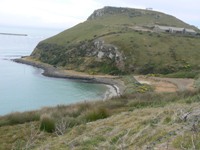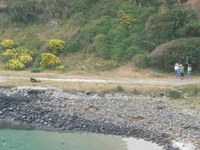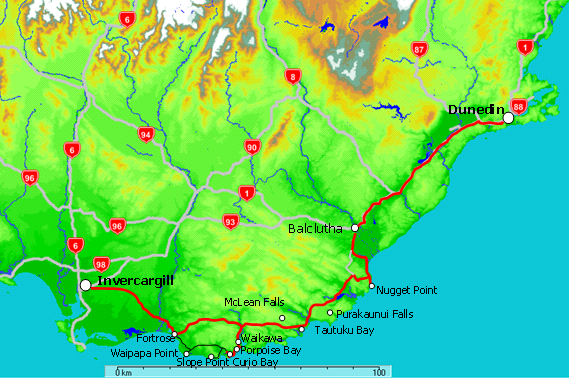
Journey time: Invercargill to Dunedin via the Catlins
4h:15m (including Curio Bay but not visiting most of the places mentioned below - allow all day)
Direct would be 3h:45m or 3h:05m if via inland SH1/93
Weather: Overcast, windy, light rain (Invercargill 21°C, Nugget Point 18°C, Dunedin rain 20°C)
One of the forgotten gems of New Zealand, " the Catlins" have been gaining a higher profile in recent years perhaps starting with exposure in the Wild South documentary series on TV.
The Catlins comprise the forest ranges, farmland and rugged coastline bounded by the Mataura and Clutha Rivers. The remote and largely unspoilt coastline and bush provide a precious haven for wildlife. Many species of animals, insects, plants and fish found here are now rare or endangered. To some extent, the Catlins represent New Zealand close to the way it was hundreds of years ago.
The prevailing weather harks from the direction of the Southern Ocean and Antarctica so it cannot be expected to be perfect every day. Fittingly today is a little overcast with a moderate breeze for our journey from Invercargill to Dunedin.
Following the Scenic Route signs from Invercargill (SH92) don't forget to turn right at Fortrose (after about 50km) if you want to see all the sights. There are numerous opportunities to stop and enjoy nature along the way so obtain a good map and leave plenty of time for the Catlins Coast leg of your journey (5hrs plus to do it properly). Some options are listed below.
Fortrose
Surprisingly, a booming port in the late 1800's till the railway arrived in 1899. Little to show for it today. At certain tides a shipwreck may still be visible in the surf.
Waipapa Point
Visit the last wooden light built in New Zealand in 1884, three years after the country's worst civilian shipwreck - the S.S. Tararua - which cost 131 lives (20 survived).
There is an 8 km sandy beach you can walk, but watch out for sea lions. Do not approach closer than 20 metres, they can move very fast when they want to.
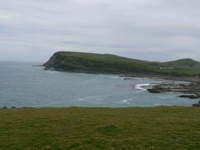
Slope Point
New Zealand's most southerly mainland point. Private land, closed in September for lambing.
Waipohatu
See an example of southern rain forest with short walk and picnic area.
Curio Bay
A great viewing point and fascinating fossilised trees (at lower tides). The Fossil Forest is estimated to be 180 million years old.
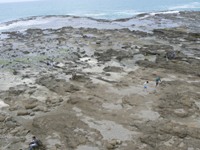
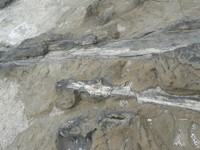
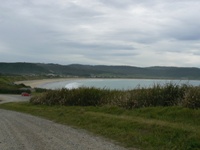
Porpoise Bay
Here we saw Hector's dolphins (presumably) bobbing up down as they fished their way round this beautiful bay. You could swim or surf the waves if the weather is conducive and maybe you'll be joined by the dolphins (they're known to like to surf too).
The road then winds past pleasant Waikawa before rejoining SH92 proper again heading for Owaka and Balclutha.
Along here your menu can include:
McLean Falls
A 40 minute return forest walk to perhaps the most striking of the waterfalls in the area. A carpark is located 3km off the main road.
Cathedral Caves
Accessible two hours either side of low tide, a 40 minute return bush walk to Wapiti Beach. A small fee is payable.
Lake Wilkie
500m South of the entrance to the Tautuku Outdoor Education Centre, a five-minute walk from the car park takes you to a viewing platform overlooking the lake, which nestles into an old dune hollow between the highway and Tautuku Bay. The track then cuts down through the forest to boardwalks around the marshy edges of the lake, about a 10-minute walk from the car park.
The sequence of vegetation along the seaward edge of the lake is regarded as unique and of special scientific value. The complete succession of vegetation from sphagnum moss on the lake edge to mature forest is compressed into a distance of less than 65 metres. Some of the main forest species growing here are rimu, miro, totara, rata, kamahi
and manuka.
A series of information panels explain the process of forest succession.
Tautuku Bay viewpoints
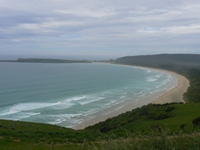
Papatowhai, Tahakopa Bay, Picnic Point
An interesting archaeological area.
This section of coast is one of the least modified in the Catlins.
Tahakopa Bay is thought to be the site of an early Maori moa-hunting camp dating back to 1000AD. Stone knives, adzes, bone fishhooks and artefacts have been found in this area.
The Catlins may have been one of the last refuges of the flightless, now extinct moa. Thirteen species have been identified from bones excavated here. They were hunted on the open mud flats of the Papatowai and Pounawea estuaries between 1000AD and 1700AD.
The dense podocarp forest covering the old mudflats and sand dunes of the estuary is also of national importance because it is one of few areas of native timber to escape the axes and chainsaws of over 100 years of saw milling.
Access to the Tahakopa Bay Scenic Reserve is from the north side of the Tahakopa River Bridge, 1.5km north of Papatowai, which is 28km southwest of Owaka.
It follows an old coastal route for horse-drawn wagons around the curve of the river to the beach at Tahakopa Bay, directly across the estuary from Papatowai.
The Old Coach Road track starts from the car park and picnic area on the north side of the Tahakopa River Bridge and passes through a narrow band of silver beech, which is normally found further inland, tree ferns and a stand of young totaras near the sea.
Walking time is about one hour for the return trip on a wide, flat track.
The gentle bush walk to Picnic Point is one of the most popular walks in the Catlins and a good introduction to the Catlins forests. The crowns of large rimu and matai emerge from the canopy of kamahi and rata. The
undergrowth is rich in ferns, spleenworts, vines and epiphytes. A large range of coastal rainforest species is identified by marker posts.
Access is sign-posted from the Papatowai domain/picnic ground on the Tahakopa River estuary. An easy bush walk through coastal forest from Papatowai to Picnic Point takes 20 minutes each way.
A return trip via the beach takes about 15 minutes.
Purakaunui Falls
One of the most publicised features of the Catlins.
The 10-minute (one-way) walk to the top viewing point is an interpretative walk, highlighting the many native trees and shrubs found in the Reserve.
Nugget Point
It's a 10-20 minute return walk to the lighthouse and/or take a 20 minute return visit to the Roaring Bay viewing hide. This is a 47 hectare reserve and is home to many of the southern coast’s animals and birds, including elephant seals, fur seals, Hooker’s sea lions, the rare yellow-eyed penguin and many other species of seabird. You may use the hide for viewing the yellow-eyed penguins and, again, remember never to approach within 20 metres of penguins or sea lions.
After Nugget Point you can follow the road past Kaka Point and the mouth of the Clutha River before rejoining SH92 to Balclutha where it might be time for lunch or afternoon tea. Here we cross the Clutha and head for Dunedin.
Those who haven't yet quenched their desire for combing long deserted beaches could turn down to Wangaloa Beach and Toko Mouth or Chrystalls Beach or Taieri Beach.
Unfortunately for us the weather deteriorates dramatically near Dunedin. Our run of fine weather is finally over. We drive up to Larnach's Castle in the late afternoon but can't see further than the gate, the rain cloud is so thick around the top of Otago Peninsula. As we make our way over the narrow roads high up on the peninsula, the cloud clears in places and we can see the viewing is spectacular up here. Must be amazing on a nice day.

Eventually we reach Taiaroa Head at the end of the Otago Peninsula in time to see a luxury ocean liner leaving Port Chalmers and threading its way out to sea through the narrow heads. Another fortuitous sight.
The albatross colony is out here but its a bit late for us to visit. A lone sea lion is spending the evening near a track, entertaining a small group of onlookers as we head back to Dunedin - along the coast road this time. It's a great drive out to the heads and back.
